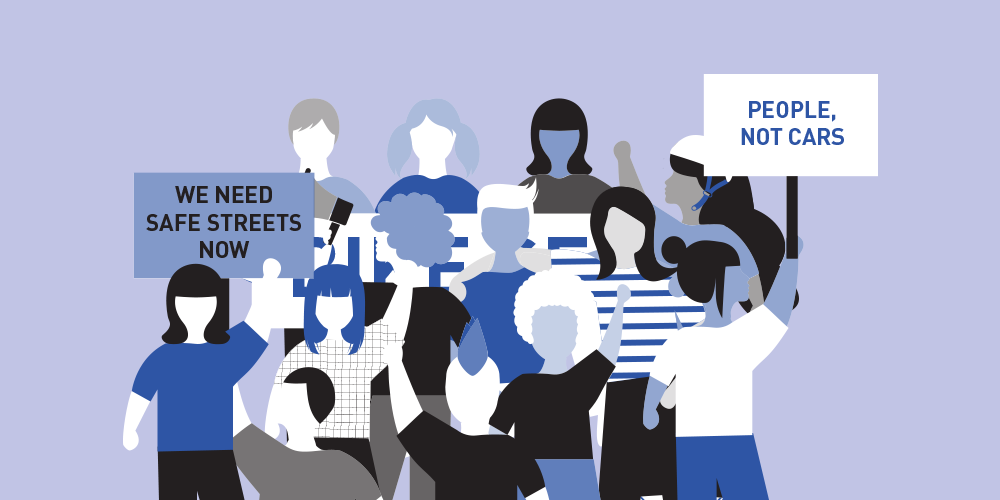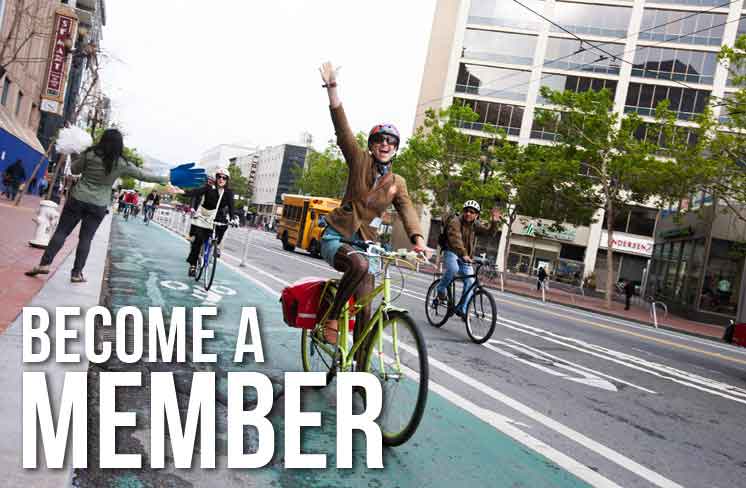On March 15, hundreds of middle and high school students marched down Market Street carrying signs reading “Youth vs. Apocalypse,” and “It’s Our Future.” As part of the worldwide Youth Climate Strike that spanned over 100 countries, these young people demanded that our representatives in Congress listen and take action to preserve a future for our people and planet.
These youth were calling out the mess they’ve inherited — indeed, many of the choices we made in years past put the future of today’s youth at risk. America’s century-old love affair with the automobile has led us to today’s reality, where city streets are designed for cars, rather than for people. Just as we now bear the brunt of decades of poor decision-making, the next generation will experience the lasting effects of the decisions we’re making today.
Changing how we build cities is no easy task, but your San Francisco Bicycle Coalition is working every day to make changes that will have positive effects on future generations. In the last year, we’ve seen some big and promising shifts. We are constructing more protected bike lanes than ever, and on Bike to Work Day, Mayor London Breed directed City staff to build 20 miles of protected bike lanes in the next two years.
It’s not just the pace of change that is shifting — it’s also who’s leading the change. Some of San Francisco’s youngest bike commuters and pedestrians have led the charge on safe streets advocacy. Whether they are going to City Hall and meeting with Supervisors or making public comment before the SF Municipal Transportation Agency’s Board of Directors, more and more youth are stepping up for safety.
Take the Westside Waves, a girls soccer team that tragically lost teammate Madlen Koteva, when the fourteen-year-old was hit and killed by a driver while walking across John Muir Boulevard near Lake Merced.
For Madlen’s teammates, it wasn’t good enough to hope that policymakers or City planners would do the right thing. Wearing their blue soccer jerseys, they went to City Hall and met with Supervisors Norman Yee and Aaron Peskin to demand action. One teammate, Leela, told the San Francisco Chronicle, “It shouldn’t take our friend to die to fix this problem.”
A couple weeks later, the young women came back to City Hall to make public comment in support of pedestrian safety improvements. There was not a single dry eye in the room as teammate after teammate pleaded for change. The improvements they advocated for passed unanimously, and pedestrian safety improvements are now under construction. The improvements will be completed by this summer.
Youth who get involved in advocacy are usually fighting to change the status quo. They bring optimism and urgency to stagnant conversations, compelling us to adopt entirely new perspectives and see old problems with fresh eyes.
Recently, when we asked our members to urge the SFMTA Board to approve protected bike lanes on Howard Street, 12-year-old Nadine Denmark wrote, “I ride to and from school a few times a week, and I know that it is safer to ride on Howard Street. But still, riding there is scary.” Reflecting on the role of cars, Nadine added, “Some days when I am thinking about global warming and what it is doing to this earth, cars pop up in my head. They are a big part of pollution. Why can’t some people see this?”
As we continue creating the San Francisco we want to live in, walk in, and bike in, we must remember that our advocacy must be the most inclusive it can be. By empowering and welcoming youth to engage in advocacy, we are cultivating the next generation of leaders who will continue fighting to clean up the mess they have inherited and work for a better city for everyone.
Nadine and Oscar Denmark, 12 and 14-year-old siblings who advocated for protected bike lanes on Howard Street
Q: Why is it important for kids to get involved in advocacy, and what do you wish adults did better?
Nadine: I think that it is important for kids to get involved because if a kid speaks up, the supervisors can see all the points of view. I wish adults would speak up for kids more and see us as citizens of San Francisco like everyone else.
Oscar: It is important for kids to advocate because it is our world as well, and we will be living on it [for many years to come].
Q: We had big wins on Howard Street. How do you feel now?
Nadine: I am excited that changes are being made, because that means all of the hard work that people are putting into this is helping a lot. It is also exhilarating to know that I was a part of this change.
Oscar: It makes me feel that I can make a change on this planet, and that in the grand scheme of things, we could end climate change, because more people will bike.
Molly Pile, 12-year-old at SF Friends School who spoke at City Hall to support protected bike lanes on Valencia Street
Q: We know that some parents at your school didn’t agree with this project. How did that affect you?
Molly: I think it helped that we were some of the first people to speak at City Hall. I am very glad that I spoke first, because I might not have felt comfortable speaking after hearing older people speak out against the project.
Q: What advice do you have for other youth looking to speak up at City Hall?
Molly: When you’re in the moment, it’s not as bad as what you thought
it would be. Just walk up and speak. Then, you want to rehearse it enough times, to be comfortable saying it without mistakes.
Editor’s Note: This article was originally published in the summer issue of our quarterly Tube Times magazine, one of many perks of membership at the San Francisco Bicycle Coalition. Not a member? Join today.


